The sticky issue of authenticity has reared its pedantic head before in this column. Does it matter that ragu bolognese would never have originally been served with spaghetti in its homeland, if we happen to like it like that? And if you stick a spoonful of Marmite in it, should you then call it something else (ragu ? la Burton upon Trent?).
But while the "original" ragu, if such a thing ever existed, is lost in the damp, fungi-scented mists of time, caesar salad, that emperor of the appetisers, proves a perfect test case ? because the recipe comes to us straight from the horse's mouth. Or at least, the horse's daughter, for the facts behind the creation are thus: the dish was invented in 1924 in Tijuana by a restaurateur by the name of Caesar Cardini, apparently to relieve the pressure on his kitchen caused by pleasure-seeking Yanks looking for liquid refreshment across the border in this era of prohibition ? it was prepared "tableside" by the waiters instead.
The legendary American food writer Julia Child recalled the theatre of it: "my parents were so excited, eating this famous salad that was suddenly very chic. Caesar himself was a great big old fellow who stood right in front of us to make it. I remember the turning of the salad in the bowl was very dramatic. And egg in a salad was unheard of at that point." Child obtained the recipe from Cardini's daughter, Rosa, but from the moment it became popular, it assumed a life of its own. From chicken strips to caviar, there seems no end to the indignities people are willing to put this poor dish through. In this case, is it possible to improve on the original?
Caesar's salad
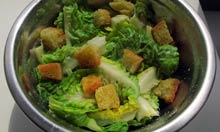 Tamasin Day-Lewis original caesar salad. Photograph: Felicity Cloake for the Guardian
Tamasin Day-Lewis original caesar salad. Photograph: Felicity Cloake for the Guardian The "authentic" recipe, or at least, the first one, is given by Tamasin Day-Lewis in her book, All You Can Eat (which, despite its name, is not a homage to American gluttony, more's the pity). It seems to have surprisingly few ingredients ? certainly in comparison to the gloopy bottled "Original Caesar Dressing" my parents deployed to coax lettuce down my infant self.
Cos lettuce leaves are tossed with a mixture of garlic-infused olive oil, egg, lemon juice and Worcestershire sauce, and then topped with some garlicky croutons and a light grating of parmesan cheese ? and a star is born. The real thing is lighter and tangier than I'm expecting, and distinctly less savoury ? it's enjoyable, but I'm not sure if it would cause a such a sensation these days, when even Boots the Chemist sells more daring lunchtime fare.
Grilled caesar
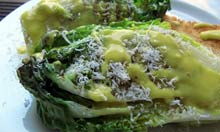 Alice Hart grilled caesar salad. Photograph: Felicity Cloake for the Guardian
Alice Hart grilled caesar salad. Photograph: Felicity Cloake for the Guardian Feeling rebellious towards all things "authentic", I move on to the most outrageous recipe I can find ? the grilled caesar salad in Alice Hart's excellent new book, Vegetarian. With a title like that, it's obvious that the grilled matter in question is not chicken, bacon, or even prawns, but the lettuce itself, which is cut in half, brushed with garlic-infused olive oil, and seared on a hot griddle pan for a couple of minutes on each side, until the outer leaves have just begun to char ? Alice is very clear that overcooked, limp lettuce is not the effect she's after here.
As a dinner party starter to stimulate conversation around the table as to the brilliance of your culinary mind in "deconstructing" the classic caesar, it's a winner ? I like the slight smokiness it imparts, and the textural contrast between the warm, tender outside and the crisp, cool middles ? but I reluctantly decide it doesn't qualify in this particular race.
Lettuce play
Day-Lewis is insistent that the lettuce should be served as whole leaves (although, she says sadly, "plenty of restaurants take no notice of that detail") ? apparently in obedience to the idea that originally the salad was designed as finger food, perhaps to save on washing up as well as preparation time. I like to get involved with my meals, but even I prefer to put a fork between me and an oily, cheesy piece of salad ? after all, something with this much raw garlic is never going to be classic seduction fare.
Caesar apparently came to a similar conclusion, because the recipe evolved, according to John Mariani's Dictionary of American Food and Drink, to call for the lettuce to be torn into bite-sized pieces: torn, mind you, rather than cut. The idea is that cut lettuce discolours more quickly, but as you need to make the salad just before serving in any case, this is entirely irrelevant ? I do think, however, that the slightly more rustic appearance, and variety of shapes and sizes, one gets from a haphazardly torn lettuce, makes it more interesting to eat. It also makes the whole preparation that bit more exciting, should you be attempting an authentic Caesar Cardini-style tableside "experience".
A question of croutons
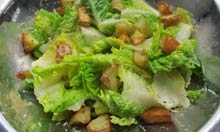 Nigella caesar salad. Photograph: Felicity Cloake for the Guardian
Nigella caesar salad. Photograph: Felicity Cloake for the Guardian One of the special geniuses of caesar salad is the textural contrast between the juicy, salty lettuce and the crunchy croutons ? the original, as recorded by Day-Lewis, is topped with sourdough bread, cut into cubes and baked with a little garlic-infused olive oil. I'm not sure these can be improved upon ? frying them in the garlic oil instead, as the Leiths Cookery Bible recipe does, makes them too greasy, so they compete with the dressing itself.
Nigella, who complains she ate more than her fair share of the "messed-about caesar salad" during her years as a restaurant critic, nevertheless goes on to give a variation (she is too modest to claim it as an improvement) upon perfection by replacing the croutons with cubes of roast potato cooked in liberal amounts of garlicky oil. Her logic is that, for a dinner party, this saves you cooking spuds for the main course ? these can be done in advance and allowed to cool slightly. It's not a bad idea (but then when are roast potatoes ever unwelcome?) but, however crunchy you get them, they're never going to compete with a crouton in the crispness stakes ? which is the whole point with this particular salad.
Dressing up
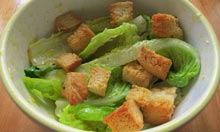 Leiths ceasar salad. Photograph: Felicity Cloake for the Guardian
Leiths ceasar salad. Photograph: Felicity Cloake for the Guardian Lots of salads contain croutons, of course ? the thing that makes the caesar special is the dressing, which has taken on a life of its own: at one point in the 1990s you couldn't move in the condiment aisle for bottled pretenders to the throne. The original is an emulsification of egg, garlic-infused olive oil, lemon juice and Worcestershire sauce ? except, because you add each ingredient to the salad individually, and then toss them together, it doesn't quite work.
Although I don't approve of the vinegar they put in (too astringent), I prefer the Leith's Cookery Bible vinaigrette-style method, whisking them all together before adding them to the salad: as the result is slightly thicker, it coats the leaves better. Everyone except Alice Hart uses a coddled, or very briefly cooked egg in their dressing, in obedience to Cardini ? this is supposed to help thicken it, but, comparing the two, I can't tell the difference, and her raw egg yolk is far less effort.
Something fishy
Of course, all these are trivial concerns compared to the real biggie: anchovies - in or out? Purists sneer at the very idea (there's even a website devoted to defending the salad against these bony invaders) maintaining if the faint fishy tang of Worcestershire sauce was enough for Caesar himself, it's enough for their refined palates.
I think such dogged insistence on authenticity is a shame: anchovies became a popular addition because their salty, intensely savoury flavour works so well in the dish, and I miss it without them: the sweet spice of Worcestershire sauce just doesn't cut the mustard. I don't like them draped whole, like so many eyebrows, across my salad though ? the flavour is too intense. Instead I like to mash them up and make them into the base of the dressing ? pure umami bliss.
Perfect caesar salad
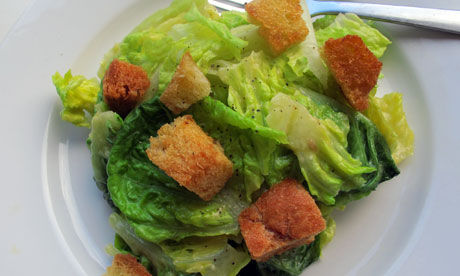 Felicity's perfect caesar salad. Photograph: Felicity Cloake for the Guardian
Felicity's perfect caesar salad. Photograph: Felicity Cloake for the Guardian Salty, tangy and crisp, caesar salad is not a particularly refined dish, and nor was it ever intended to be; all this fussing about anchovies and torn lettuce is missing the point. Hell, if you want to be really authentic, eat it with your fingers ? just don't stint on the cheese or the oil. This is proper drinking food, prohibition-style.
Serves 4
2 cloves of garlic
150ml olive oil
4 slices of day-old white sourdough bread
2 cos lettuces, torn into rough pieces
2 anchovy fillets, rinsed
1 egg yolk
Juice of ? lemon
Large handful of finely grated parmesan
1. Crush the garlic and add to the oil. Leave to infuse for at least an hour. Preheat the oven to 200C and cut the bread into rough crouton-sized cubes. Toss with a little of the oil to coat, and then bake for about 15 minutes until golden and crisp.
2. Mash the anchovies against the bottom of your salad bowl until you have a paste, then beat in the yolk, and gradually the rest of the garlic-infused oil until you have a thickish dressing. Stir in the lemon juice and taste ? season if necessary.
3. Put the leaves into the bowl and toss well to coat. Add the cheese and toss well again. Top with the croutons and serve immediately.
Is Caesar Cardini's creation the emperor of salads, or a mere citizen of the romaine republic? Should we stick to his recipe, or are tweaks acceptable in the name of improvement ? and how far can we go before it becomes something else entirely? And lastly, anchovies ? we all agree they're essential, right?
Source: http://www.guardian.co.uk/lifeandstyle/wordofmouth/2011/jul/13/how-make-perfect-caesar-salad
facebook announcement labradoodle airplay picasso picasso napoleon dynamite sensa
No comments:
Post a Comment
Note: Only a member of this blog may post a comment.